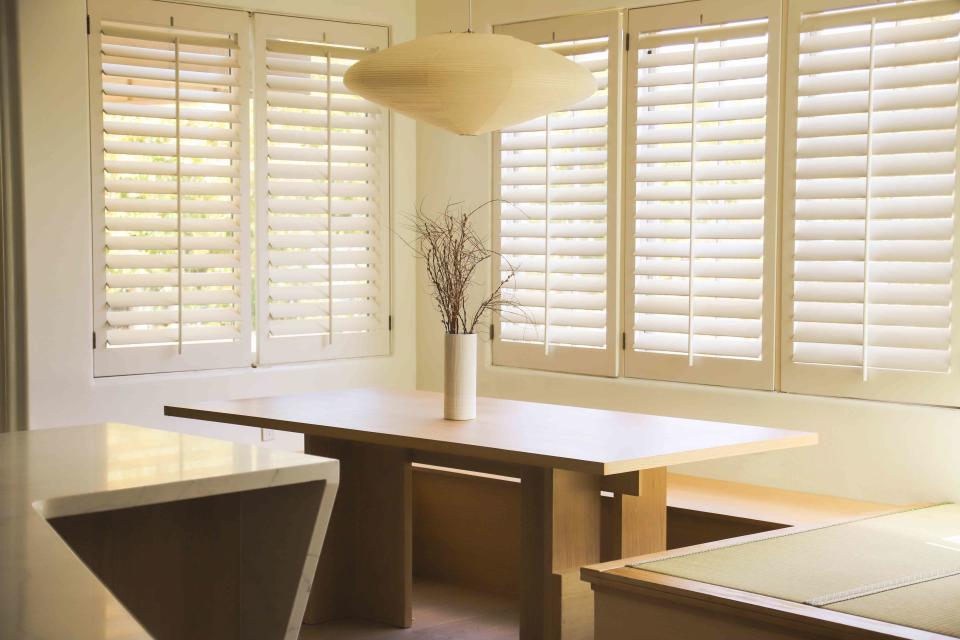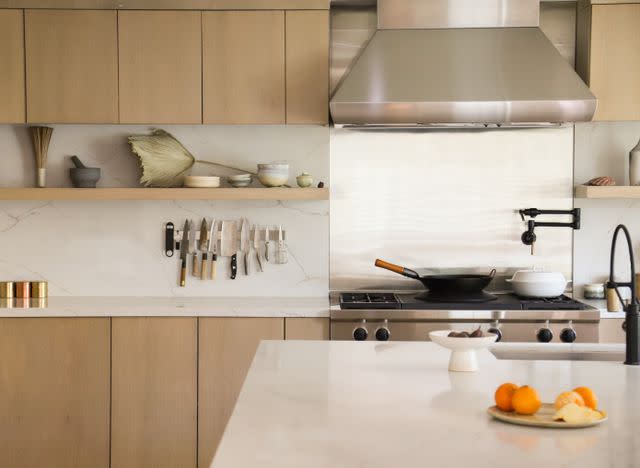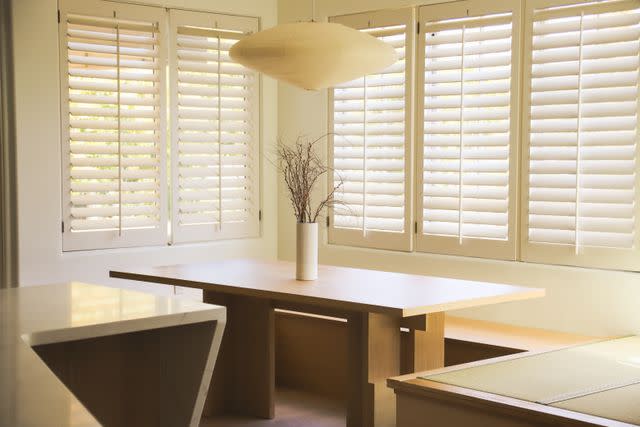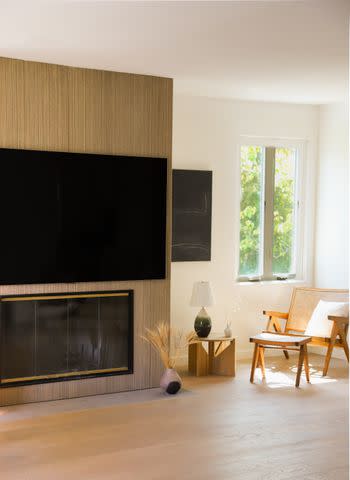Japandi Style Is a Fusion of 2 Popular Design Aesthetics—Here's How to Use the Trend in Your Home
Japanese design meets Scandinavian in this marriage of complementary styles. Here are the fundamental elements and how to get the look.

Justin Chung for OWIU Design
In the interior design world, styles cycle in and out of fashion. But just when it seems there’s nothing new under the sun, as the proverb goes, an ethereal blend of East meets West sweeps across social media feeds. The new aesthetic fuses the zen of Japanese design with the cozy simplicity of Scandinavian décor—the result is called Japandi style.
"Historically, Scandinavian design has been heavily influenced by Japanese style, so it makes sense why these two aesthetics work so well together," says Joel Wong and Amanda Gunawan, co-founders of OWIU Design. "Both carry similar qualities of minimalism, clean lines, and lighter material palette schemes."
It is an advantageous pairing, with both parts perfectly accentuating the other. "The timeless blend of Japanese and Scandinavian design styles beautifully marries simplicity and warmth,” says Elizabeth Vergara, founder and lead designer of Vergara Homes. "Complementing the minimalist aesthetic of Japanese design, we embrace the cozy warmth characteristic of Nordic interiors."
Read on as our experts explain more about the essential elements of Japandi style and how you can get the look in your home.
Meet Our Expert
Joel Wong and Amanda Gunawan, co-founders of OWIU Design, an architecture and design studio based in Los Angeles
Elizabeth Vergara, founder and lead designer of Vergara Homes, a high-end residential architectural design and renovation studio
Related: 16 Most Common Interior Design Styles, From Art Deco to Scandinavian

Justin Chung for OWIU Design
What Is Japandi Style?
Japandi is a meld of Japanese and Scandinavian design principles. Whereas Japanese design places a strong emphasis on natural materials and simple lines, Scandinavian design brings in homey, handcrafted furnishings and textiles. What they share is a minimalistic and functional approach.
There is a lot of open space in both aesthetics, and the objects that occupy that space are chosen with care and deliberation for their sparse beauty and functionality. "We love the calming nature of such spaces as they evoke a sense of serenity and peacefulness, spaces where your eyes are not distracted by unnecessary ornamentation and design," say Wong and Gunawan. "We find that 'public spaces’ in the home where you might host visitors are especially well paired with the Japandi style. Places like the kitchen, dining room, and living areas—'spaces of gathering'—where you don’t want to distract from the company with too many objects.”
The Japandi aesthetic evokes both calm and comfort. And that’s welcome at a time when many more of us are working in our homes, which means spending more time there. We're craving a functional yet peaceful environment and Japandi style answers that need.
The Key Principles of Japandi Style
The key principles of Japandi style are minimalism and simplicity and that plays out in the use of natural materials and a light color palette. "Functionality and practicality are key, with every element serving a purpose to maintain a clutter-free and efficient living environment," says Vergara.
Clean Lines and Minimalist Design
The Japandi look is neat and organized. "Drawing from Japanese design principles, we opt for sleek, minimalist furniture and design elements, prioritizing clean lines and uncluttered spaces to create a sense of calm and order," says Vergara.

Justin Chung for OWIU Design
Use of Natural Materials
Both Japanese and Scandinavian traditions revere woodworking, and both cultures are renowned for skilled carpentry and furniture making. In Japandi style, there is a strong emphasis on materials such as wood, stone, and woven textiles. This adds warmth to a space and connects a home's inhabitants to nature. "We incorporate natural materials like wood, bamboo, and stone, which we combine with warm organic textures, fostering a connection with nature and enhancing the overall tranquility of a room," says Vergara.
Related: Biophilic Design Is About Connecting With Nature—Here's How to Utilize the Décor Trend In Your Home
Emphasis on Functionality and Simplicity
In a Japandi home, there is an emphasis on functionality and purpose. "Pieces can have dual purposes like banquettes that can also act as a place to take a nap or a custom futon that folds into the ground for additional living space," says Wong and Gunawan.
Balance Between Warmth and Minimalism
While a spare space can sometimes be cold, Japandi style gets around that with light and soft textures. "Utilizing natural light, soft textiles in muted tones, and an overall neutral color palette, our goal is to create an inviting atmosphere that strikes a perfect balance between minimalism and comfort," says Vergara.
Related: Both Minimalism and Maximalism Are Trending—Interior Designers Explain the Surprising Coexistence
Elements of Japandi Style
Japandi style is really an ethos as much as a look and feel. "Japandi is more than just design elements; it is a way of living," says Wong and Gunawan. "Supporting a healthy and meaningful lifestyle—prioritizing elements that mean the most to those specific homeowners."
Wood Furniture and Décor
Wood is a plentiful raw material in both countries, and this is reflected in home furnishings and décor. "Raw materials are very in line with Japandi; things like the use of wood is a major theme throughout, and playing around with different types and stains to add tonal interest is a signature to the design," says Wong and Gunawan. "As far as furniture, Japandi traditionally includes functional pieces with clean details."

OWIU
Neutral Color Palette
While Scandi style is known for pops of colors, such as rust, green, and blue against a neutral backdrop, the Japandi palette allows the neutrals to stand alone. "Choosing whites, off-whites, beige, and taupes for a minimalist palette allows other design details to stand out," says Wong and Gunawan.
Related: These 10 Neutral Paint Colors Are Interior Designer-Approved—Shop Them Now
Natural Textiles, Pillows, and Throws
It is very common to see pillows, cushions, and woven throws as well as woven straw in Japandi style. "Using natural textiles, and elements like hemp and rice straw—textiles that are easy to clean and comfortable to the touch," says Wong and Gunawan.
How to Create a Japandi-Inspired Space
To incorporate Japandi style in your home, be guided first by the sources of light in your rooms. "Design around bright spaces with lots of natural light," says Wong and Gunawan. "Considering where the natural light source is in a project and how you can work around that so it can stay unobstructed—that’s the true jewel of any space."
Next, choose furniture sparingly, emphasizing function. Then add ceramics and stone objects that are both useful and beautiful. Finally, layer in some softer textiles. "Select furniture crafted from natural materials such as wood and stone, adorned in neutral tones like beige, grays, white, and black," says Vergara. "Adding tactile elements like linen curtains and pillows, shearling or sheepskin accent chairs, and neutral-tone rugs that further enhance a serene and harmonious ambiance. These elements capture the essence of Japandi style in every corner of a living space."
Read the original article on Martha Stewart.

